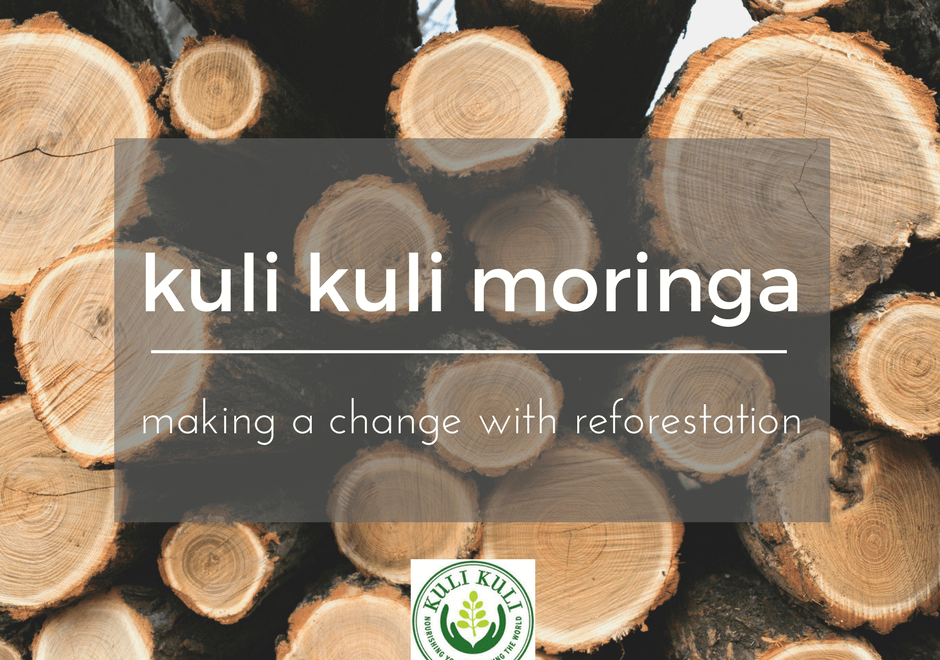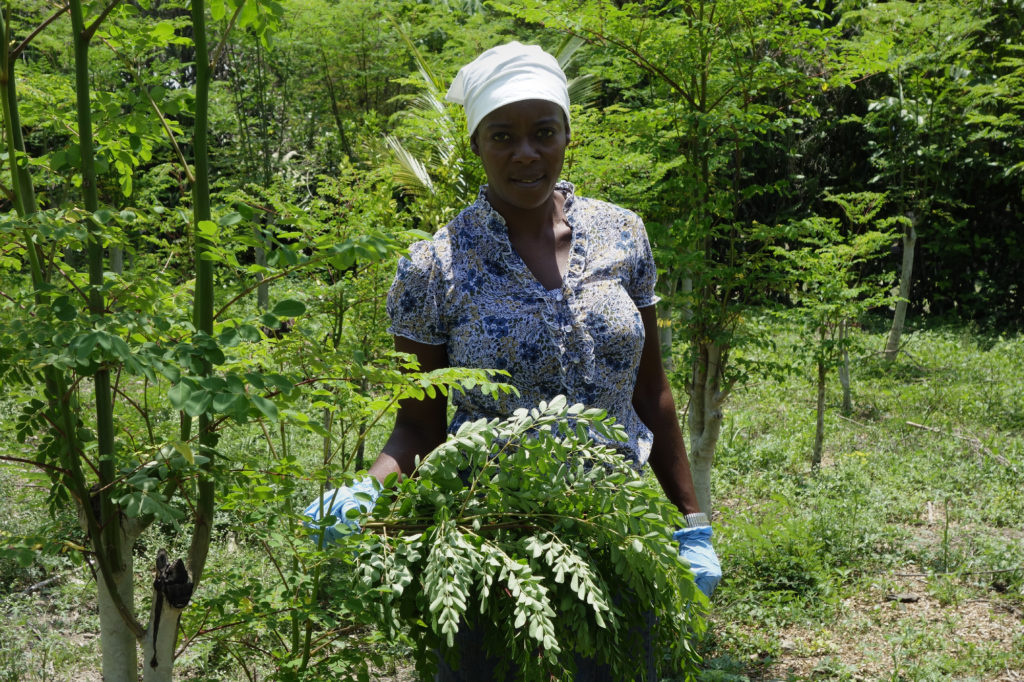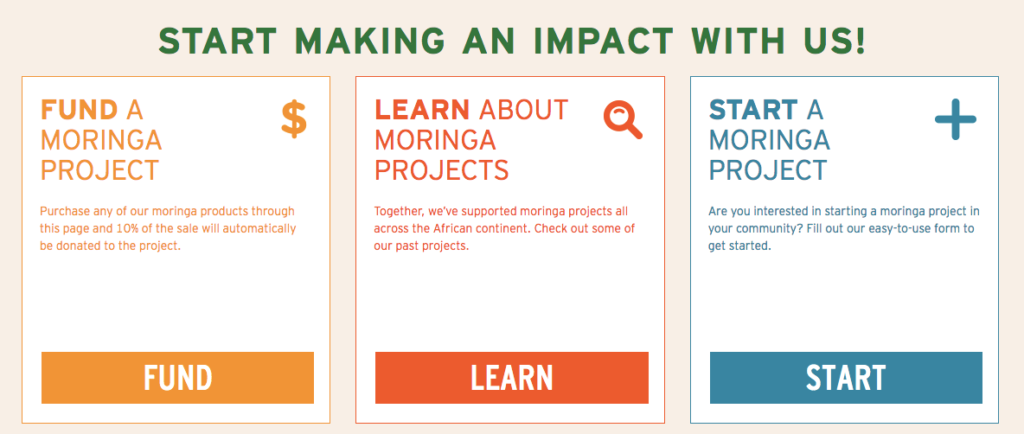
Why are we so obsessed with moringa trees over here at Kuli Kuli?
Because they do so much more than just give us extra vitamins and minerals in our green smoothies.
Moringa leaves are nutritionally superior to other greens, making them a great aid against malnutrition.
The moringa tree grows in virtually every climate and is super low-maintenance, making it a great long-term form of nutrition all over the world.
Moringa trees do not need to be cut down when harvested, making them the most economical crop for farmers.
By incorporating moringa into your daily habit you are doing good work for both your body and the Earth. You can check out how moringa is especially good for women, supports beautiful, luscious hair, lowers blood pressure, promotes good sleep, and even makes a killer moisturizing face mask.
As for this post? Let’s check out how moringa is good for the environment.
Deforestation
Kuli Kuli recently posted an in-depth breakdown of deforestation and why it is ruining our planet. If you want to get into the details of deforestation then head over to that post and do a quick read-through.
Forests are being removed from our Earth at an alarming rate. Deforestation is removing essential parts of the ecosystem needed for basic survival. As our world population continues to increase, the need for resources becomes even more dire. Rather than searching for sustainable ways to provide these resources to the people of the world, we are hacking at the existing land for immediate resources.
As a result, the Earth is dying and not so slowly.
Deforestation and the Soil
Our forests are our natural air purifiers, canceling out toxic carbon deposits so that we can live, breathe, and thrive here. The forests also help maintain soil composition so that plants can continue to grow without being washed away by heavy rainfalls or powerful rivers.
Don’t believe me?
Check out what happens in Haiti every time a tropical storm passes through their side of the island in the Caribbean.

Deforestation is evident on the border of Haiti and the Dominican Republic. The left side is Haiti; The right side the Dominican Republic.
This isn’t unique to Haiti, though. It happens all over the world, wherever entire swaths of land have been cleared for farming or agricultural purposes.
Deforestation is mostly led by agricultural expansion and livestock ranching, which can severely deplete the soil of its nutrients. Both of these processes make it nearly impossible for new growth to naturally come in.
What makes this especially devastating is that there is no true “quick fix” for this major environmental problem. Even if we could mobilize enough people to combat deforestation, it is a long, slow process. The devastating effects on the soil make it difficult to replenish the vacant land with more trees.
This is where the act of reforestation becomes an important and delicate task in order to save the world.
Importance of Reforestation
As news spread that deforestation was destroying the planet, many governments around the world simply abandoned the deforested land. The problem with this, though, is that said land is too damaged to regrow its forests naturally. This is where reforestation projects are an incredibly important step in saving the Earth.
“Saving” sounds a little bit dramatic, doesn’t it?
Well, consider this: deforestation has changed the atmospheric composition on our planet. It has changed so drastically that entire weather patterns have shifted to the point of destroying entire species of animals. (Did you know that we are currently in our sixth mass extinction?)
One way to combat this damage is through reforestation, by planting enough trees to compensate for the negative effects of global deforestation. The recent push for reforestation certainly offers a lot of promise for climate change. However, it takes a very long time for us to actually reap the benefits.
Reforestation efforts begin with seedlings, which can take several decades to mature. Considering the current rate at which our Earth is dying, we may not have several decades to wait for these benefits.
While reforestation is definitely the best way to save our planet for the long term, it does little to combat global warming right.this.very.minute. One of the main disadvantages of reforestation is time, itself.
How Moringa Helps With Reforestation
Remember all those stellar benefits that the moringa oleifera tree offers?
Well, the list of benefits continues to grow:
- The moringa tree is a fast-growing tree that reaches maturity just nine months after planting.
- It is drought-tolerant and highly resistant to various environmental conditions.
- The fast-growing trees replenish the soil with vital nutrients and provide a form of natural irrigation to surrounding crops and plants.
- The roots of the mature trees serve as a support structure for the soil so that it is less likely to be washed away in heavy rainfall.
A secure and nourished soil allows for the new growth of other plants and trees, proving the moringa tree to be one of the best reforestation tools for immediate effect.
In many places, such as Haiti, the advantages of reforestation and replacement planting are huge. Not only do the moringa trees offer profound nutrition to people in impoverished areas but they also fight against deforestation and global warming.
In fact, Kuli Kuli is already committed to its own reforestation project with Smallholder Farmers Alliance to plant moringa trees in Haiti.
What You Can Do to Help
Kuli Kuli moringa comes from women-led farming cooperatives from all over the world, many of which are in regions that have fallen victim to deforestation. Our recent work in Haiti is the perfect example of how Kuli Kuli Moringa is currently impacting change. By purchasing our products, your are helping to support this mission as 10% of our profits go to projects like this one.
Still not enough for you?
Through our Moringa Partners Program, we fund other moringa projects just like ours. Head over to our Impact page to check out our current projects. If you see one that you like then you will find more information on how to get involved!
Or maybe you have an idea of your own, in which case you can start your own project, instead. Kuli Kuli provides financial and marketing support to projects that use moringa to combat malnutrition and deforestation. Submit your idea, today!
Saving the planet and its inhabitants is a huge task, but we are up for it. The first step is education. The next step is up to you.












How can I get moringa saplings?
My Company intends to cultivate Moringa Oleifera in the Republic of South Africa. The purpose of the project is to manufacture Biodiesel for the transportation sector and mitigate Carbon Dioxide emissions. Please note that the targeted area shall be 65 thousand ha of marginal land.
Actually we shall have the finance from some British Banks but we are looking to employ a reputable experienced German entity. Could you elaborate with us and recommend such interested entity.?